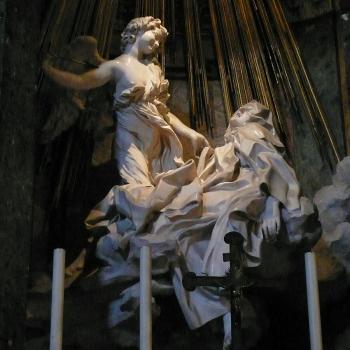A very quick post about Terrence Malick’s Tree of Life.
I am not the audience for this movie–a meditation on loss, nature and our part in it, the guilts of childhood (ok this one I’m the audience for), with a lot of breathy abstract voiceovers and actors I don’t much care for. I often found myself trying to consider that the imagery might be “not for me” rather than, you know, trite. Malick teases the Tushnet viewer with hints about the political context of the 1950s white suburban childhood he depicts, but none of that ever goes anywhere except as a fleeting, generic example of how all our idylls come pre-shattered. (Not wrong but also not enough for my tastes.) THAT SAID there are some really good things in this movie, including one scene which is astonishing, honestly worth the 2+ hours of highly symbolic waterfalls all on its own. This is the Creation scene set to Zbigniew Preisner’s “Lacrimosa.”
I’m not gonna link you to just this scene because you should watch it in the movie itself. Basically a mother has just lost her son. In agony she lashes out at God (the movie is inspired by the Book of Job) and this is the response: a vision of the creation of our universe, scored to a repetitive, anguished cry, written as a requiem for the composer’s friend, filmmaker Krzysztof Kieslowski. A woman cries out again and again and her tears suffuse the universe. All Creation is throbbing with her pain, all of it residing somehow within her broken heart. The mystery of creation, yes, as in Job (“Where were you…”). The way human loss is a loss within Creation, as at the Fall. And also the way the Lord of the Universe, our Creator, takes up our pain into Himself. Darkness at noon, the torn veil of the Temple.
I don’t know anything about Malick’s own beliefs but I’ll say this is an exceptionally startling and moving Crucifixion scene. Unforgettable.
There are other good things here as well, even from my unsympathetic perspective. The tree itself is great. They found a real good tree. Victor Morton lays out the movie’s structure quite well here (scroll down), although I’d add that I really like that it isn’t solely the son’s spiritual journey. The mother also moves through rage to surrender, yielding up her child into the Lord’s arms (or like “to the universe” but I’ve never understood that kind of thing so I will just say it is Christian) and thereby receiving him again. Her arc deepens the movie’s portrayal of its themes and also, along with the more attenuated portrayal of the father’s journey, suggests lives intertwining like the double helix as they move toward God.
The father’s spiritual arc is more closely tied to an ethical and even imo political surrender–the loss of his prestigious job is part of what allows him to repent of his previous severity and individualism. I wish the film had done more with how that arc might play out in the life of the surviving son. We get this one powerful image of clouds reflected against a skyscraper, almost taking over the great monuments of success: All that is solid melts into air; or also, the skyscraper becomes a window onto a better way of life. I get that the film is more attuned to metaphysics/faith/imagery than ethics/service/action, but a) those obviously can’t be untwined and b) I’ll personally never be happy with movies that give their characters epiphanies that change nothing in their material position…. If what I’m saying is that I’d watch an extra hour of a movie I mostly did not enjoy, I’m okay with that.
Tree via Wikimedia Commons.











